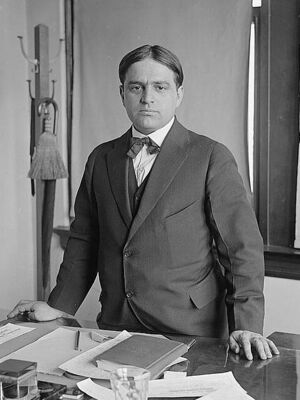Difference between revisions of "Fiorello LaGuardia"
m (Text replacement - " served as " to " was ") |
m (Text replacement - "the powerful" to "the influential") |
||
| Line 30: | Line 30: | ||
'''Fiorello Henry LaGuardia''' was an American attorney and politician who represented New York in the [[United States House of Representatives|House of Representatives]] and was the 99th [[Mayor of New York City]] from 1934 to 1945. Known for his irascible, energetic, and charismatic personality and diminutive, rotund stature, La Guardia is acclaimed as one of the greatest mayors in American history.<ref>He was ranked first in Melvin G. Holli, ''The American Mayor'' (1993)</ref> La Guardia was frequently cross-endorsed by parties other than his own, including the [[Democratic Party (United States)|Democratic Party]], under New York's electoral fusion laws. | '''Fiorello Henry LaGuardia''' was an American attorney and politician who represented New York in the [[United States House of Representatives|House of Representatives]] and was the 99th [[Mayor of New York City]] from 1934 to 1945. Known for his irascible, energetic, and charismatic personality and diminutive, rotund stature, La Guardia is acclaimed as one of the greatest mayors in American history.<ref>He was ranked first in Melvin G. Holli, ''The American Mayor'' (1993)</ref> La Guardia was frequently cross-endorsed by parties other than his own, including the [[Democratic Party (United States)|Democratic Party]], under New York's electoral fusion laws. | ||
| − | Before serving as [[Mayoralty of Fiorello La Guardia|mayor]], La Guardia represented [[Manhattan]] in [[United States Congress|Congress]] and on the [[New York City Board of Aldermen]]. As mayor, during the [[Great Depression]] and [[World War II]], La Guardia unified the city's transit system; expanded construction of public housing, playgrounds, parks, and airports; reorganized the [[New York City Police Department|New York Police Department]]; and implemented federal [[New Deal]] programs within the city. He pursued a long series of political reforms, curbing the power of the | + | Before serving as [[Mayoralty of Fiorello La Guardia|mayor]], La Guardia represented [[Manhattan]] in [[United States Congress|Congress]] and on the [[New York City Board of Aldermen]]. As mayor, during the [[Great Depression]] and [[World War II]], La Guardia unified the city's transit system; expanded construction of public housing, playgrounds, parks, and airports; reorganized the [[New York City Police Department|New York Police Department]]; and implemented federal [[New Deal]] programs within the city. He pursued a long series of political reforms, curbing the power of the influential [[Tammany Hall]] political machine and re-establishing merit-based employment and promotion within city administration.{{sfn|Kessner| 1989}} |
La Guardia was also a major national political figure. His support for the [[New Deal]] and relationship with President [[Franklin D. Roosevelt]] crossed party lines, brought federal funds to New York City, and cut off patronage to La Guardia's enemies. La Guardia's WNYC radio program "Talk to the People", which aired from December 1941 until December 1945, expanded his public influence beyond the borders of the city.<ref>https://web.archive.org/web/20180614194741/https://www.wnyc.org/series/talk-to-the-people</ref> | La Guardia was also a major national political figure. His support for the [[New Deal]] and relationship with President [[Franklin D. Roosevelt]] crossed party lines, brought federal funds to New York City, and cut off patronage to La Guardia's enemies. La Guardia's WNYC radio program "Talk to the People", which aired from December 1941 until December 1945, expanded his public influence beyond the borders of the city.<ref>https://web.archive.org/web/20180614194741/https://www.wnyc.org/series/talk-to-the-people</ref> | ||
Latest revision as of 13:07, 18 October 2024
(politician) | ||||||||||||
|---|---|---|---|---|---|---|---|---|---|---|---|---|
 | ||||||||||||
| Nationality | US | |||||||||||
| Alma mater | New York University | |||||||||||
Mayor of New York City from 1934 to 1945.
| ||||||||||||
Fiorello Henry LaGuardia was an American attorney and politician who represented New York in the House of Representatives and was the 99th Mayor of New York City from 1934 to 1945. Known for his irascible, energetic, and charismatic personality and diminutive, rotund stature, La Guardia is acclaimed as one of the greatest mayors in American history.[1] La Guardia was frequently cross-endorsed by parties other than his own, including the Democratic Party, under New York's electoral fusion laws.
Before serving as mayor, La Guardia represented Manhattan in Congress and on the New York City Board of Aldermen. As mayor, during the Great Depression and World War II, La Guardia unified the city's transit system; expanded construction of public housing, playgrounds, parks, and airports; reorganized the New York Police Department; and implemented federal New Deal programs within the city. He pursued a long series of political reforms, curbing the power of the influential Tammany Hall political machine and re-establishing merit-based employment and promotion within city administration.[2]
La Guardia was also a major national political figure. His support for the New Deal and relationship with President Franklin D. Roosevelt crossed party lines, brought federal funds to New York City, and cut off patronage to La Guardia's enemies. La Guardia's WNYC radio program "Talk to the People", which aired from December 1941 until December 1945, expanded his public influence beyond the borders of the city.[3]
References
- ↑ He was ranked first in Melvin G. Holli, The American Mayor (1993)
- ↑ Kessner 1989.
- ↑ https://web.archive.org/web/20180614194741/https://www.wnyc.org/series/talk-to-the-people
Wikipedia is not affiliated with Wikispooks. Original page source here